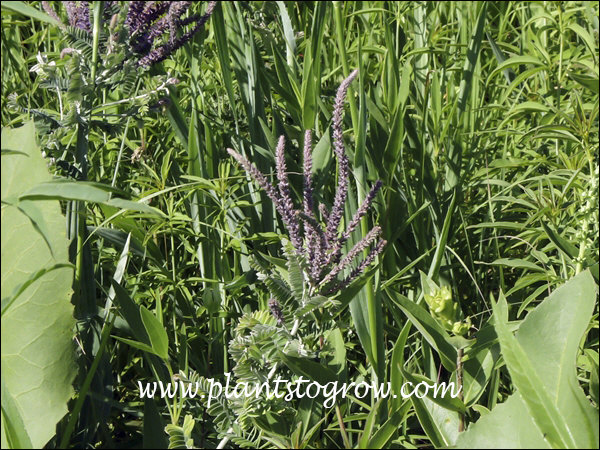| Description | Lead Plant (Amorpha canescens) is a small, hardy shrubby plant. A native prairie perennial survives dry sites. |
|---|---|
| Pronunciation | (ah-MOR-fah)( kan-ESS-senz) |
| Plant Type | Perennials Hardy, Wild Flowers, Site author's observations |
| Hardiness Zone | 3-8 |
| Sunlight | full |
| Moisture | Very drought-tolerant plant growing in average to dry conditions. |
| Soil & Site | mesic to dry prairies, sandy to loamy soils |
| Flowers | Deep purple to blue and found in dense spike-like clusters. The individual small flowers are tubular, have a green calyx, purple petals, and 10 protruding orange-tipped stamens |
| Leaves | Silvery gray, alternate, compound, and up to 50 narrow leaflets. Canescens means covered in short hairs that are usually white or gray, very fine and short |
| Roots | It is long and stringy, hence the name Prairie Shoe Lead Plant. Lead Plant is a nitrogen-fixing plant that forms a tap root. |
| Dimensions | Forms a few branched shrub reaching up to 3 feet. |
| Propagation | The seeds need to be scarified and moist stratified for at least 30 days. |
| Misc Facts | The leaves are covered in grey pubescence, which gives them a gray tint and makes the plant appear to have been dusted with lead. |
| Author's Notes | I have seen this plant many times in prairies. The silvery-gray foliage makes it stand out among the other plants. |
| Notes & Reference | #56-Tall Grass Prairie Wild Flowers, #224-Prairie Nursery web site (www.prairienursery.com), #288-The Gardeners Guide to Prairie Plants (Neil Diboll, Hilary Cox) |

Cart








